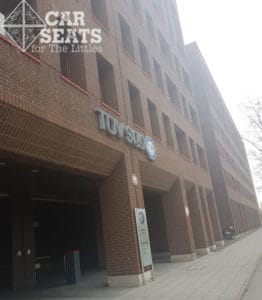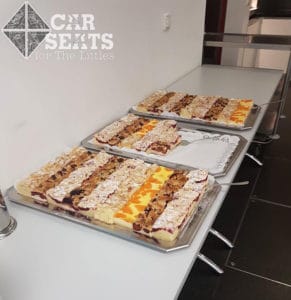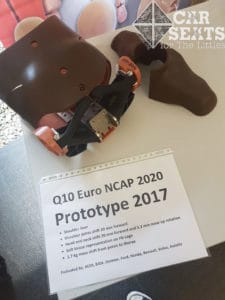The 16th conference for the Protection of Children in Cars took place in the same venue in Munich as it did last year. There was a free workshop for all attendees on the 5th of December, with the actual conference running from the 6th-7th of December.
Like last year, it was incredible to join so many like-minded individuals from all around the globe in the beautiful city of Munich. We had speakers and guests from the likes of France, Sweden, Germany, and even as far away as Canada, the USA, Australia and Korea, to name a few! Representatives from Safe Kids Worldwide, the Children’s Hospital of Philadelphia (CHOP), VOLVO Sweden, Transport Canada, Hyundai, Ford and many more attended the event. Despite the large reach of nationalities, the conference was held in English.
The organisers described this year’s event thusly:
“The 2018 Conference offers a detailed view on international CRS markets, their relevant safety regulations/testing systems, and results from accident studies, showing improvement but still challenges the future. New mobility concepts and transport configurations up to future autonomous vehicles may influence the design, the use of child restraint systems and safety cultures in general.”
Workshop – 5th December 2018
The Workshop that ran on the 5th was a free event for all attendees. It’s a much smaller event, with a specific aim at any attendees who “are interested in sociocultural aspects in road traffic”.
There were only a handful of different talks presented, but the talks by Lorrie Walker of Safekids Worldwide (USA), and Kristy Arbogast from CHOP highlighted a topic that had never crossed my mind – Autonomous Cars. Lorrie’s talk was titled – “Influence of Future Autonomous Cars on Child Safety: Considering child passenger safety when designing, developing and marketing autonomous vehicles”
Wondering what an autonomous car is? Techopedia defines it as – “…a vehicle that can guide itself without human conduction. This kind of vehicle has become a concrete reality and may pave the way for future systems where computers take over the art of driving. An autonomous car is also known as a driverless car, robot car, self-driving car or autonomous vehicle.”
Both Lorrie and Kristy spoke about Autonomous Vehicles, and how their design may affect future designs for child restraint systems. Lorrie shared information about a report that had been made by a Blue Ribbon Panel that’s studying this topic. The 10 page report is available for download. This new topic represents the future of child passenger safety so we’re eager to see how this technology develops.
Day One – 6th December
The actual conference started off the next day, with some wonderful refreshments served by the venue. Once I had got my name tag, some wifi codes and a drink, I found a seat (which turned out to be the same seat as last year!) and sat ready to learn. I was thrilled to recognise some faces and names from last year already.
Like last year, the conference began with a warm welcome by Prof. Dr. Klaus Langweider, International Safety Consulting.
Happy Birthday, ISOFIX
Constandinos Visvikis from CYBEX GmbH, presented a paper titled: “ISOFIX at 20 years: The past, present and future”.
In case you’re not familiar with ISOFIX – ISOFIX is the European version of LATCH. We have rigid connectors which connect to ISOFIX points in the vehicle seat, sometimes with a base, support leg, and/or top tether. Mr Visvikis shared the very interesting tidbit that originally at the very start, ISOFIX had 4 connections to the vehicle!
Farid Bendjella from Britax Römer Kindersicherheit GmbH, presented Results and Learnings on Car/CRS interactions from Euro NCAP Child Occupant Protection. He shared that the combination of a backless booster cushion and the vehicle restraint system (so, curtain airbags) offer a good level of protection.
This was a result from using a Q10 dummy sitting on a backless booster cushion during some crash testing. He felt that there was a good vehicle safety environment for introducing backless booster cushions into regulations. He noted that in respect to child occupants, the belt geometry is improving.
As I listened to his presentation, I couldn’t help but think of the now-defunct Bin the Booster campaign that sought to only have high back boosters available. Our older booster riders are still safe in their backless booster seats, like they were during the campaign.
Sjaan Koppel from the Monash University Accident Research Centre (Australia), presented a paper on behalf of her colleague, Inam Ahmed and also acknowledged her other colleagues Brian Fildes and David Logan. Ms Koppel shared Ms Ahmed’s results from “Findings on Child Restraint System use in Dubai”.
In the UAE (United Arab Emirates), injuries are one of the leading cause of death in children. Two out of three fatally injured children who die in the UAE do so as a result of a motor vehicle crash. That’s around three times the global average.
The Dubai Traffic Safety has set a challenging goal: reducing car-related deaths from the current rate by 2021. The purpose of this research was to find out the knowledge, attitude, and behaviours relating to the correct child occupant travel within Emirate of Dubai of the UAE.
A survey of 23 questions was made, and presented to willing participants. The overall results showed that a high number of participants culturally didn’t seem to care about the law, and that there was a significant proportion of 4-7 year olds who travelled unrestrained.
The results gained were being shared with the relevant parties with the aim to understand local culture and work out the best way to convene the safest options.
Matthias Kühn (Unfallforschung der Versicherer, GDV; Gerd Müller, Technical University Berlin; Wolfgang Fastenmeier, Mensch Verkehr Umwelt, Institut für Angewandte Psychologie) presented a paper regarding the “handling of child restraint systems (CRS) with special focus on the misuse topic”. From this paper, he shared that younger parents (under 30 years of age) typically seemed to seriously misuse car seats, or wrongly install them. He also noted that there was some misuse for parents of the 40-59 years of age bracket. There was a correlation of misuse rates between nationality, and presented the question of how can we better address people with different understandings? Mr. Kühn also shared that most people were not aware there was a problem with their seat installation or how they secured the child; lack of knowledge and child securing itself were the top three reasons for misuse given by interviewed persons.
He concluded that we don’t need better car seats, we need better education.
Seungkyu Kang, Hyundai Motor Company, presented his paper “Hyundai Santa Fe Child Presence Detection System to protect kids from heat-related death in vehicles”. At CSFTL, we feel very strongly about sharing awareness of hot car deaths, or vehicular heatstroke.
Mr Kang spoke about the Greenhouse effect. This is where the heat (short wave radiation) coming into the vehicle bounces off the seats/dash, but then becomes stuck within the vehicle. Now you have long wave radiation stuck inside the vehicle. He also stressed that memory failure can happen to anyone. Mr Kang then went on to share the Child Presence Detection System in the Hyundai Santa Fe, which is a new system on 2019 models that alerts parents to a child who’s in the back seat when the vehicle doors are locked.
Day Two – 7th December
The second day kicked off with Katarina Bohman presenting her paper “A comparison of Q10 update and current Q10 dummies in frontal and side impact sled tests”. Ms Bohman acknowledged her colleagues Isabelle Stockman, Lotta Jakobsson, Maria Wimmerstedt, Volvo Cars; Dion Kruse Autoliv Research, Håkan Sundmark Autoliv Sverige.
The study included frontal and side impact testing for three different dummies – the original Q10, the Q10 update and Q10 light. These dummies represented a 10 year old. She noted that the first Q10 update had maybe made the dummy too stable – as we saw in some crash test comparisons of all three. We saw how the shoulder belt didn’t react as expected. It was interesting seeing crash tests of these dummies.
There was a crash test dummy on display in the break area. It was fascinating to see one up close!
Up next to speak was Matthew R. Maltese, presenting a paper entitled “Vehicle pitch in frontal crashes – implications for children in the rear rows.” He acknowledged his colleagues Joshua Snitzer, Seth Fein, Children’s Hospital of Philadelphia, Center for Injury Research and Prevention. We know that in a frontal collision, when the vehicle is moving forward, it will typically hit the wall and then typically rebound back some. But then a movement upwards (known as “pitch”) can sometimes (but not always) occur upon the rebounding back. We were shown crash tests which showed this. I’ve watched quite a few vehicle crash tests up to this point in my CPS career, but i’d never noticed the movement Mr Maltese was referring to in his paper. They had used publicly available data from NHSTA on 17 crash tests of family friendly vehicles and conducted in depth, high speed crash tests. It was discovered that the vehicles didn’t always respond in the expected way (pitching upwards), but some rotated downwards.
Damien Subit from Dorel France presented his paper “Not in-crash infant comfort and safety” and acknowledged his colleague François Renaudin. His paper was all about the new lie flat Maxi Cosi Jade car seat, which we saw in Cologne at the Kind und Jugend tradefair. It was interesting to hear more about this seat. Mr Subit confirmed that when installing the seat, it’s not possible to install it the wrong way on the base – the head must always be in the centre of the vehicle. He also shared that it’s a heavy seat (weighing in at around 4.5kg).
Wrapping Up
There were so many amazing presentations, but we couldn’t possibly mention them all. I was absolutely thrilled to have had the opportunity to be in a room with so many people who all share the same goal: keeping children safer on every ride.





